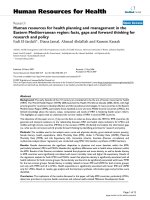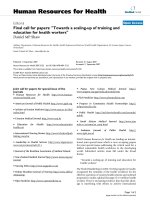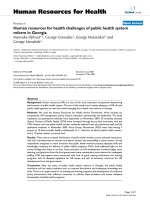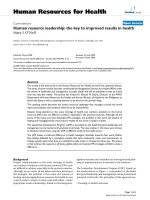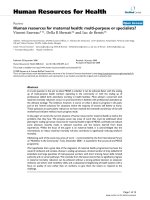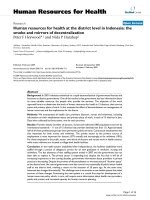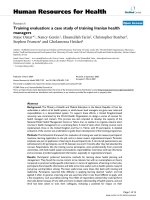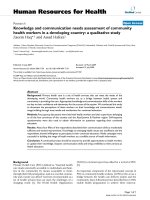báo cáo sinh học:" Human resources for health challenges of public health system reform in Georgia" docx
Bạn đang xem bản rút gọn của tài liệu. Xem và tải ngay bản đầy đủ của tài liệu tại đây (211.92 KB, 7 trang )
BioMed Central
Page 1 of 7
(page number not for citation purposes)
Human Resources for Health
Open Access
Research
Human resources for health challenges of public health system
reform in Georgia
Mamuka Djibuti*
1
, George Gotsadze
2
, George Mataradze
3
and
George Menabde
1
Address:
1
Tbilisi State Medical University, 33 Vazha-Pshavela Ave., 0177 Tbilisi, Georgia,
2
Curatio International Foundation, Tbilisi, Georgia and
3
Curatio International Consulting, Tbilisi, Georgia
Email: Mamuka Djibuti* - ; George Gotsadze - ;
George Mataradze - ; George Menabde -
* Corresponding author
Abstract
Background: Human resources (HR) are one of the most important components determining
performance of public health system. The aim of this study was to assess adequacy of HR of local
public health agencies to meet the needs emerging from health care reforms in Georgia.
Methods: We used the Human Resources for Health Action Framework, which includes six
components: HR management, policy, finance, education, partnerships and leadership. The study
employed: (a) quantitative methods: from September to November 2004, 30 randomly selected
district Centers of Public Health (CPH) were surveyed through face-to-face interviews with the
CPH director and one public health worker randomly selected from all professional staff; and (b)
qualitative methods: in November 2004, Focus Group Discussions (FGD) were held among 3
groups: a) 12 district public health professionals, b) 11 directors of district public health centers,
and c) 10 policy makers at central level.
Results: There was an unequal distribution of public health workers across selected institutions,
with lack of professionals in remote rural district centers and overstaffing in urban centers. Survey
respondents disagreed or were uncertain that public health workers possess adequate skills and
knowledge necessary for delivery of public health programs. FGDs shed additional light on the
survey findings that there is no clear vision and plans on HR development. Limited budget, poor
planning, and ignorance from the local government were mentioned as main reasons for inadequate
staffing. FGD participants were concerned with lack of good training institutions and training
programs, lack of adequate legislation for HR issues, and lack of necessary resources for HR
development from the government.
Conclusion: After ten years of public health system reforms in Georgia, the public health
workforce still has major problems such as irrational distribution and inadequate knowledge and
skills. There is an urgent need for re-training and training programs and development of conducive
policy environment with sufficient resources to address these problems and assure adequate
functionality of public health programs.
Published: 27 May 2008
Human Resources for Health 2008, 6:8 doi:10.1186/1478-4491-6-8
Received: 31 July 2007
Accepted: 27 May 2008
This article is available from: />© 2008 Djibuti et al; licensee BioMed Central Ltd.
This is an Open Access article distributed under the terms of the Creative Commons Attribution License ( />),
which permits unrestricted use, distribution, and reproduction in any medium, provided the original work is properly cited.
Human Resources for Health 2008, 6:8 />Page 2 of 7
(page number not for citation purposes)
Background
The World Health Report 2006 documents the wide-
spread health workforce crisis across the globe [1]. Similar
to other regions and specialty areas, there has been a
shortage of well trained public health workers in the Cen-
tral and Eastern Europe/New Independent States (CEE/
NIS) region as well [2].
Public health is defined as the science and art of prevent-
ing disease, prolonging life and promoting health,
through the organized efforts of society. It has a popula-
tion rather than an individual focus and involves mobiliz-
ing local, regional, national and international resources to
ensure the conditions in which people can be healthy
[3,4]. Performance of the public health system depends
on multiple factors, among which human resources (HR)
are one of the most important components [5]. The public
health workforce requires up-to-date knowledge and skills
to deliver essential public health services. To meet the
training and continuing education needs of an evolving
workforce, a clearer understanding of the functions and
composition of the public health workforce both now and
for the future is required [6].
Under the Soviet era, a highly centralized 'San-Epid'
(sanepid) network focusing on environmental and epide-
miological health was put in place in Georgia. Perhaps the
most tangible achievement of the sanepid system was
high immunization coverage and communicable disease
control; however, it was relatively ineffective in combat-
ing environmental pollution, occupational diseases and
noncommunicable diseases [2]. Public health workers
employed by the sanepid system were mainly graduates
from sanepid faculties of State medical institutes/universi-
ties, having completed a five-year course largely focusing
on environmental health and infectious disease epidemi-
ology and control. Graduation was followed by central-
ized training within continuous professional education
programs. The 5-year course also included basic medical
education (anatomy, physiology, biochemistry, etc.) as
well as some clinical training (internal medicine, infec-
tious diseases, surgery, etc.), and graduates were given an
MD degree with specialization in epidemiology, environ-
mental health, nutrition, etc. Sanepid system was a part of
the entire health care system under the Ministry of Health
umbrella management, and human resources were
mainly managed by employing Soviet command and con-
trol approaches and style. Reporting lines were clearly
defined under regulations of the Ministry of Health, and
there was a strong accountability framework put in place.
Following independence, Georgia embarked on health
sector reforms, the main focus of which was a moderniza-
tion of public health services combined with decentraliza-
tion efforts. In 1996, a dedicated Department of Public
Health (DPH) was established to give greater emphasis to
health promotion and disease prevention, ensure suffi-
cient budget allocation for health promotion activities
and encourage innovative community initiatives contrib-
uting to prevention of diseases [7]. The role of the DPH,
which is part of the Ministry of Labour Health and Social
Affairs (MoLHSA), was to monitor and assess the epide-
miological situation of the population and to promote
good health through education and management of pre-
ventive health services. In line with the decentralization
policy implemented in the country, the MoLHSA sup-
ported establishment of local centers of public health
(CPH), responsible for implementing public health activ-
ities on a district level [8].
Ten years later, after the initiation of health sector reforms
in Georgia, investments in system building innovations
had not resulted in sustainable health gain: over the past
decade there has been a substantial increase in the inci-
dence of sexually transmitted diseases, drug abuse, cardi-
ovascular diseases, cancer, injuries as well as prevalence of
smoking [9-11].
Recognizing the diversity of factors influencing unfavour-
able population health status, including low budget allo-
cations to public health, weaknesses in organizational
structure, poor legislation, lack of stewardship, the gap
between private and public medicine, etc. [12,13], it could
be argued that having an inadequate public health work-
force (given that in Georgia, public health workers are
mainly physicians, – i.e. graduates of sanepid faculties –
'public health workforce' here is defined as physicians
providing essential public health services to promote
physical and mental health and prevent diseases, injury,
and disability), which has not been successful in assum-
ing new roles and responsibilities, is also a significant con-
tributing factor. The problem might be that while
embarking on reforms there was no clear understanding
of what are the competing needs for workforce supply in
public health programs and activities considering the new
mission, i.e. giving greater emphasis to health promotion
and diseases prevention? What resources are available at
central and district level? How does the new mission fit
with human resource existing capacities? What do we
need to do? This is an incomplete list of important ques-
tions that have to be answered to enable the public health
system to deliver the necessary interventions.
The aim of this study was to assess adequacy (which
denotes numbers, necessary skill mix, and adequate geo-
graphical distribution) of human resources of public
health relative to the needs of the system under health
care reforms. To the best of our knowledge, it is the first
study in Georgia which has assessed the current status of
the public health system by analysing the influence of
Human Resources for Health 2008, 6:8 />Page 3 of 7
(page number not for citation purposes)
multiple factors of human resources development, supply
and distribution.
Methods
Study design
The study is comprised of two components: a) quantita-
tive study – survey of centers of public health, and b) qual-
itative study – Focus Group Discussions (FGD) of selected
professionals. From September to November 2004, 30
randomly selected, local CPH (of total of 66 in the coun-
try) were approached to collect quantitative data. Face-to-
face interviews were conducted with CPH directors, who
are most knowledgeable about staffing, educational back-
ground and professional experience of the employed pub-
lic health workers and available resources and
organizational structure of their units.
For the quantitative survey we used adapted questions
from the Management Science for Health's HR Manage-
ment Assessment Tool [14]. In each CPH, the survey col-
lected data on public health workers demography and
employment history as well as directors opinions (meas-
ured on a five point Likert scale) on HR management
practices, available policies, funding levels and education
attainment of the professional staff.
Alongside a director, in each CPH, one public health
worker was randomly selected from all professional staff
working at the facility and detailed information about
training courses undertaken over the past three years in
epidemiology, biostatistics, health policy and planning,
health information systems, disease surveillance, etc., was
obtained. The survey also enquired about additional cre-
dentials (e.g. certificates and diplomas) for self reported
data verification.
For data analysis we used the recently elaborated Human
Resources for Health Action Framework that includes six
components – HR management, policy, finance, educa-
tion, partnerships, and leadership, which is expected to
enable countries in developing a concrete national health
workforce strategy that could be supported and imple-
mented in a planned and systematic manner [15].
Quantitative data were analysed by SPSS software. The
main analysis was descriptive.
The Qualitative study was implemented in November
2004 through FGDs among local public health profes-
sionals and policy makers at central level. In total, three
focus groups were formed: a) 12 district public health pro-
fessionals (4 from rural districts, 4 from urban districts,
and 4 from larger cities/regional centers), b) 11 directors
of district public health centers (4 from rural districts, 4
from urban districts, and 3 from larger cities/regional
centers), and c) 10 policy makers at central level (repre-
sentatives of the Parliament of Georgia, MoLHSA units
such as Department of Public Health, Department of
Health Policy, and Department of Regulations).
Separate FGD guides were developed for each group.
Questions aimed at understanding opinions regarding HR
management (e.g. the vision and plans for HR develop-
ment), policy (e.g. whether legislation and regulations
support public health system to have well trained staff),
finance (e.g. adequacy of resources to satisfy training
needs), education (e.g. relevance of training courses to
activities and skills required by public health programs).
Furthermore, special inquiries were made concerning fac-
tors influencing the hiring and retention of trained profes-
sionals. Discussions also captured professional staff/
directors' and policy maker's views about possibilities to
address emerging challenges in the HR area. External facil-
itators managed the FGD and created a comfortable envi-
ronment for participants to openly voice their opinions.
FGDs were audio taped and transcribed. The standard
methodology was applied for qualitative analysis[16].
Notes were translated into English and selected quota-
tions are presented in the text.
The study protocol was approved by the Institutional
Review Board of Tbilisi State Medical University. Partici-
pants were included in the study only after obtaining writ-
ten informed consent.
Results
Quantitative results
There were no refusals from the survey respondents (30
CPH directors and 30 randomly selected employees – one
per CPH). The total number of public health workers
employed at the surveyed 30 CPHs was 277, out of which
85% were females. The mean age of these public health
workers was 43.3 years. The average number of public
health workers per CPH was 9.2, ranging between 2 and
16 persons. The average length of working experience in
their current public health job was 11.15 years, ranging
between 3.6 and 26.5 years (Table 1). The distribution of
professional staff varied across studied CPHs – for exam-
ple, 10 remote rural district CPHs (33.3%) did not have
any epidemiologists, whereas 5 urban district CPHs
employed five and more epidemiologists.
Assessment of HR policy, management, and funding
issues at the CPH level showed that CPH directors, on
average, neither disagreed nor agreed that in Georgia, the
Public Health System has a coherent vision for HR devel-
opment. They agreed that there are no budgetary provi-
sions for HR development activities in their CPH. Overall,
CPH directors agreed that there is no staff specifically
Human Resources for Health 2008, 6:8 />Page 4 of 7
(page number not for citation purposes)
charged with responsibility for HR functions, and no
annual HR development plans exist in their CPH, whereas
they disagreed that in their CPH they have an organiza-
tional policy manual, all members of staff have job
descriptions, and formal staff evaluation is performed reg-
ularly (Table 2).
All 30 selected centers were implementing four federal
programs financed by the state: a) infectious disease sur-
veillance; b) health promotion; c) immunization program
monitoring; and d) malaria prevention. When CPH direc-
tors were asked about the relevance of public health work-
ers' knowledge and skills against the activities required by
these programs (i.e. needs assessment, program planning,
monitoring and evaluation, data analysis, fin/admin
management), CPH directors, on average, neither disa-
greed nor agreed that public health professionals pos-
sessed sufficient skills and knowledge (Table 3).
Among 30 randomly selected public health professionals
(one person from each centre), 13 (43.3%) respondents
did not take any training course over the past three years
in public health, epidemiology, biostatistics, health policy
and planning, health information systems, disease sur-
veillance, etc.
Focus group discussions
Policy environment
It was said in all three groups that there is lack of adequate
legislation addressing HR needs for the public health sys-
tem. Although, work has recently started on public health
law, which is expected to address the HR challenges.
"We do not know any legal documents setting require-
ments for training and professional development of pub-
lic health professionals " (CPH public health worker)
"There is no legislation regulating HR development issues
for public health system.
Two new laws are pending – one is the law on public
health and second the law on
continuous medical education. We hope that these two
laws will really improve the
situation " (Policy maker at central level)
HR management
All respondents thought that MoLHSA had no clear vision
for HR development issues when reforms were initiated.
Policy makers are of the opinion that they have developed
a vision for HR development in the public health area,
although as of yet there is no concrete plan.
"We do not remember any plan or activity addressing HR
development at the beginning of the reform. Maybe now
it does exist at central level, however we do not know any-
thing about it here " (CPH public health worker)
"In reality, we are just making first steps to shape our
vision and develop realistic plans to address pending HR
issues within the system " (CPH director)
"Yes, we definitely have a vision on HR development for
the public health system, however it is not reflected yet in
Table 1: CPH public health workers demographic and employment data
CPH public health workers demographic and employment data (N = 277) 95% CI Min; Max
Mean age of public health workers 43.3 41.5–45.1 32; 53
Share of females among public health workers 236 (85%)
Average number of public health workers per CPH 9.2 7.8–10.6 2; 16
Average length of working experience in current public health job (years) 11.1 9.1–13.2 3.6; 26.5
Table 2: CPH directors' judgment on various statements about HR policy, management, and funding issues in their CPH
Statements about HR policy, management, and funding issues in CPH Mean values and SD from Likert scale
In Georgia, Public Health System has a coherent vision for HR development 3.27 (1.05)
Our CPH has a coherent vision for HR development 3.20 (1.06)
There is special budget allocated for HR development activities in our CPH 1.60 (0.56)
No staff specifically charged with responsibility for HR development functions in our CPH 4.00 (1.20)
No annual HR development plan exists in our CPH 4.33 (0.55)
Employee data (# of staff, skill/education level, etc) exists in our CPH 4.46 (0.51)
In our CPH personal folders exist for each staff member 4.50 (0.58)
Our CPH has its organizational policy manual 2.37 (0.76)
All members of staff in our CPH have job descriptions 2.50 (0.97)
Formal staff evaluation is performed regularly at our CPH 2.03 (0.81)
Note: (Likert scale values: 5 = strongly agree; 4 = agree; 3 = neither disagree nor agree; 2 = disagree; 1 = strongly disagree).
Human Resources for Health 2008, 6:8 />Page 5 of 7
(page number not for citation purposes)
concrete plans. Although we realize that there is a great
need in developing such plans in the nearest future "
(Policy maker at central level)
Funding
FGD participants were consistent in admitting financial
resource deficiency and lack of adequate motivations for
public health system workforce. Diverse factors such as
insufficient funding, lack of local government's interest in
services offered by CPH, poor motivations created for
CPH staff, etc, all affect negatively HR issues for public
health system (Half of the CPH funding comes from the
central budget (salary supplement and operational costs
for implementation of federal programs) and half from
the local municipal budget (mainly covers the CPH staff
base salaries). Training courses that are occasionally pro-
vided to public health workers are usually funded through
various international donor funded programs, and are
mostly free of charge for participants).
"Resources are very limited, especially within the munici-
pal budget, which does not allow us to do much for train-
ing and development of our staff " (CPH director)
"Major reason is lack of adequate funding for public
health services. Originally it was up to the central level to
staff local CPH. When responsibilities were delegated to
districts, local governments became reluctant to finance
CPH staff adequately " (CPH director)
"There is no motivation for a public health professional to
work in a remote rural or mountainous area. Maximum
salary is 120 GEL a month (approximately US$ 65), which
is definitely not enough, and no additional living
expenses are provided. It is clear that one can not find
good professional who would agree to go there on that
money " (Policy maker at central level)
"Due to low salaries, public health professionals do not
have motivation to perform well. At present, there are lim-
ited job opportunities in Georgia; otherwise many of
them would leave their current jobs " (Policy maker at
central level)
Education
Low capacity of national training institutions, lack of ade-
quate training programs and lack of coherent further
training were mentioned by all FGD participants. CPH
professionals were not happy with the quality of training
courses, often being a formality and/or place for corrup-
tion. Concerns were also expressed with regard to the reli-
ance on donor funded episodic training courses, and their
sustainability.
"There are neither good training institutions nor good
training programs, though we are required to pass exams.
There are only episodic training courses provided by inter-
national organizations " (CPH public health worker)
(Note: In Georgia, public health professionals are
required to pass exams for certification
"There were some post graduate training courses (dura-
tion 4 months) we had to undertake but it was just a for-
mality and place for corruption – i.e. participants could
pay some money, not attend the training and still receive
a certificate " (CPH public health worker)
"There are definitely some efforts and activities, but the
problem is that they are episodic. Lectures and seminars
that are offered do not have regular basis, and thus it is not
enough to achieve good results " (Policy maker at central
level)
Partnerships
Lack of coordination between national level institutions
and donor funded programs were mentioned as factors
not contributing to HR development for public health sys-
tem.
"There is often duplication in training programs offered
within the framework of different programs. In other
words, they focus on the same topics, whereas other
important topics are not covered at all " (CPH director)
Table 3: CPH directors' judgment on various statements about skills and knowledge necessary for the implementation of four federal
programs
Our CPH public health professionals possess sufficient
knowledge and skills for:
Mean values and SD from Likert scale
Health promotion Disease surveillance Immunization monitoring Malaria prevention
a. Needs assessment 2.64 (0.64) 2.57 (0.63) 2.57 (0.63) 2.63 (0.65)
b. Program planning 2.80 (0.71) 2.70 (0.70) 2.70 (0.70) 2.75 (0.68)
c. Monitoring & Evaluation 2.80 (0.65) 2.80 (0.66) 2.80 (0.66) 2.79 (0.66)
d. Data analysis 2.64 (0.64) 2.73 (0.64) 2.73 (0.64) 2.67 (0.64)
e. Fin/admin management 2.84 (0.75) 2.66 (0.81) 2.66 (0.81) 2.75 (0.85)
Note: (Likert scale values: 5 = strongly agree; 4 = agree; 3 = neither disagree nor agree; 2 = disagree; 1 = strongly disagree).
Human Resources for Health 2008, 6:8 />Page 6 of 7
(page number not for citation purposes)
Leadership
Linkage of the CPH staff with the rest of the system is very
poor. There are no organizational links with either public
or private healthcare facilities, and there is no clear format
for managing supervising health facilities and providers
[17]. In line with these observations, CPH directors stated
that it is difficult for them to provide direction and lead-
ership to healthcare facilities and providers. CPH manag-
ers are frustrated – they never manage to get support from
the local government and to mobilize resources for HR
development.
"I have to explain to them who we are and why our service
is important for the population" (CPH director)
"We are tired of requesting support from the local govern-
ment, therefore we do not attempt to request any more"
(CPH director)
Proposed recommendations
A number of recommendations emerged from FGDs in
support of HR development that included both practical
measures for immediate action and strategies for medium
to long term. As for immediate action, major emphases
were placed on development of effective policies to ade-
quately distribute public health professionals across the
country and retain them in remote rural areas as well as
increase the funding for public health services to augment
the salaries of local public health professionals. For the
medium to long term, the highest priority was given to the
elaboration of a national plan for HR development within
the public health system, development of appropriate
training programs, and establishment of a school of pub-
lic health offering a master of public health (MPH) course.
"The government should develop effective policy to ade-
quately distribute public health staff across the country,
including remote rural areas " (Policy maker at central
level)
"Funding for public health services should be increased.
In the first place, this should be reflected in the salaries of
local public health professionals " (CPH director)
"In the long run, we may think about establishing a of
school of public health, which would provide an MPH
course " (Policy maker at central level)
Discussion
This study describes a wide array of challenges that hinder
HR development for public health system in Georgia. Our
results are limited to the extent that respondents were
frank and open. For example, the focus group context is
important to consider because it affects the comfort level
of participants and, consequently, how openly they
respond to questions
16
. However, findings of FGD, e.g.
lack of good training institutions and programs, are con-
sistent with the results of the quantitative study showing
that CPH professional staff do not possess sufficient skills
and knowledge necessary for the implementation of pub-
lic health programs.
Our results suggest that after ten years of health system
reforms in Georgia, the current public health system has
major deficiencies such as unequal distribution and low
technical competence of public health workers, as well as
poor HR management practices at district CPH. The rea-
sons determining this inadequacy might include lack of
adequate legislation, lack of vision and clear policies for
HR development, limitations in funding, low technical
capacity of national training institutions, lack of coordi-
nation between national level institutions and donor
funded programs, lack of leadership, etc. It should be said
that the challenges identified by this research have also
been documented elsewhere in the countries of CEE/NIS.
Namely these challenges include: inadequate funding,
weak legislative framework, weak organization of services,
etc. Taken together, these deficiencies have had a negative
impact on the public health workforce, manifested in low
qualification of public health workers [2]. Globally speak-
ing, it is of interest that while Georgia has not suffered
from the AIDS pandemic, the results seem to be the same
as in other countries severely affected by AIDS – poor
motivation and performance due to poor management
and lack of investment in an efficient HR infrastructure
[18].
Results of our study indicate that there may be an urgent
need in improving the knowledge and skills of public
health professionals in Georgia. Similar needs were suc-
cessfully addressed in several countries in the region,
where schools of public health have been established
[2,19,20].
It should be said that research results helped to identify
new directions for strengthening the public health system
through HR development in Georgia.
New law on public health
Firstly, the country embarked on development of a new
public health law, which was passed by the Parliament in
June 2007. The law has a special section on human
resources, which defines MoLHSA roles and responsibili-
ties in the development of human resources as well as
requirements for education and continuous professional
development of public health professionals.
School of Public Health
The second important initiative has been the establish-
ment of the school of public health under the auspices of
Human Resources for Health 2008, 6:8 />Page 7 of 7
(page number not for citation purposes)
the Tbilisi State Medical University. Involvement of the
cadre of young Georgian professionals educated abroad
and setting up an international partnership with leading
international public health training centers have been the
main strategic approaches that have been employed for
establishing the Georgian School of Public Health.
However, without adequate planning for the number and
type of staff to be produced by these institutions and with-
out designing appropriate incentives for staff retention
and motivation as well as improved HR management
practices, the impact of new policies and improved educa-
tion would be marginal. Workers alone are not panaceas.
Building a high-performance workforce demands a hard,
consistent, and sustained effort. For workers to be effec-
tive they must have necessary inputs, and for them to use
these inputs efficiently they must be motivated, skilled,
and supported [21]. Our study highlighted these needs,
thus the Government of Georgia has to make further
efforts to tackle the health workforce problems for public
health.
Conclusion
After ten years of health system reforms in Georgia, the
current public health system has major deficiencies such
as unequal distribution and low technical competence of
public health workers, as well as poor HR management
practices at district centers of public health.
There seems to be an urgent need for improving the
knowledge and skills of public health professionals in
Georgia. One of the solutions to successfully addressing
these problems might be the establishment of the school
of public health.
This should be accompanied with adequate planning for
the number and type of staff to be produced by this insti-
tution and designing appropriate incentives for staff reten-
tion and motivation, as well as improved HR
management practices at local centers of public health.
Competing interests
The authors declare that they have no competing interests.
Authors' contributions
MD and GG conceived the research and study design, lead
the analysis and drafted the manuscript. GM and GM con-
tributed to study design and assisted with reviewing the
manuscript. All authors read and approved the final man-
uscript.
Acknowledgements
We are grateful for the funding offered by the Alliance of Health Policy and
Systems Research in carrying out this research.
References
1. WHO: The world health report 2006: Working together for
health. World Health Organization 2006.
2. Figueras J, McKee M, Cain J, Lessof S: Health systems in transi-
tion: learning from experience. World Health Organization (on
behalf of the European Observatory on Health Systems and Policies) 2004.
3. Acheson D: Committee of Inquiry into the future develop-
ment of the Public Health Function. In Public Health in England
London: HMSO; 1988.
4. Allin S, Mossialos E, McKee M, Holland W: Making decisions on
public health: a review of eight countries. World Health Organi-
zation (on behalf of the European Observatory on Health Systems and Pol-
icies) 2004.
5. Committee for the Study of the Future of Public Health,
Division of Health Care Services, Institute of Medicine: The
Future of Public Health. The National Academy Press, Washing-
ton, D.C; 1988.
6. The Public Health Workforce: An Agenda for the 21st Century.
A Report of the Public Health Functions Project. U.S. Depart-
ment of Health and Human Services, Public Health Service 1999 [http://
www.health.gov/phfunctions/pubhlth.pdf].
7. Ministry of Health of Georgia: National Health Policy, Ministry of
Health, Georgia. .
8. Gamkrelidze A, Atun R, Gotsadze G, MacLehose L: Health Care
Systems in Transition Georgia. European Observatory on Health
Care Systems 2002.
9. National Center for Disease Control and Medical Statistics: Health
Statistics Yearbook, National Center for Disease Control
and Medical Statistics, Georgia. 2005.
10. Nadareishvili M, Phkhakadze V, Tsaqadze R: Tobacco Products
and Use in Georgia. State Department of Statistics 2002.
11. WHO: European Health for All statistical database. [http://
www.who.dk/hfadb]. accessed 25 September 2006
12. Telyukov A, Paterson M, Gotsadze G, Jugeli L: Situation Analysis
for a New Strategy of Technical Assistance in the Health
Care Sector of Georgia. Partners for Health Reformplus (PHRplus)
2003.
13. Hotchkiss D, Eisele T, Djibuti M, Silvestre EA, Rukhadze N: Health
system barriers to strengthening vaccine-preventable dis-
ease surveillance and response in the context of decentrali-
zation: evidence from Georgia. BMC Public Health 2006, 6:175.
14. Management Sciences for Health: Human Resource Management
Assessment Tool. Management Sciences for Health, Boston,
Massachusetts. Spring 1999.
15. Dal Poz M, Quain E, O'Neil M, McCaffey J, Elzinga G, Martineau T:
Addressing the health workforce crisis: towards a common
approach. Human Resources for Health 2006, 2:21.
16. De Negri B, Thomas E: Making Sense of Focus Group Findings:
A Systematic Participatory Analysis Approach. Washington,
DC: Academy for Educational Development; 2003.
17. Esmail LC, Cohen-Kohler JC, Djibuti M: Human resource man-
agement in the Georgian National Immunization program:
a baseline assessment. Human Resources for Health 2007, 5:20.
18. The Health Sector Human Resource Crisis in Africa: An Issues
Paper. United States Agency for International Development, Bureau for
Africa, Office for Sustainable Development 2003.
19. Lock K, McKee M: Development of public health training in
Hungary – an exercise in international co-operation. Journal
of Public Health Medicine 1995, 17:438-444.
20. ASPHER: The collaborative effort of the Open Society Insti-
tute and the Association of Schools of Public Health in the
European Region (ASPHER). [ />C_projects/osi/osi_aspher.htm]. accessed 25 September 2006
21. Chen L, Evans T, Anand S, Boufford JI, Brown H, Chowdhury M,
Cueto M, Dare L, Dussault G, Elzinga G, Fee E, Habte D, Hanvo-
ravongchai P, Jacobs M, Kurowski C, Michael S, Pablos-Mendez A,
Sewankambo N, Solimano G, Stilwell B, de Waal A, Wibulpolprasert
S: Human resources for health: overcoming the crisis. The
Lancet 2004, 364:1984-90.
